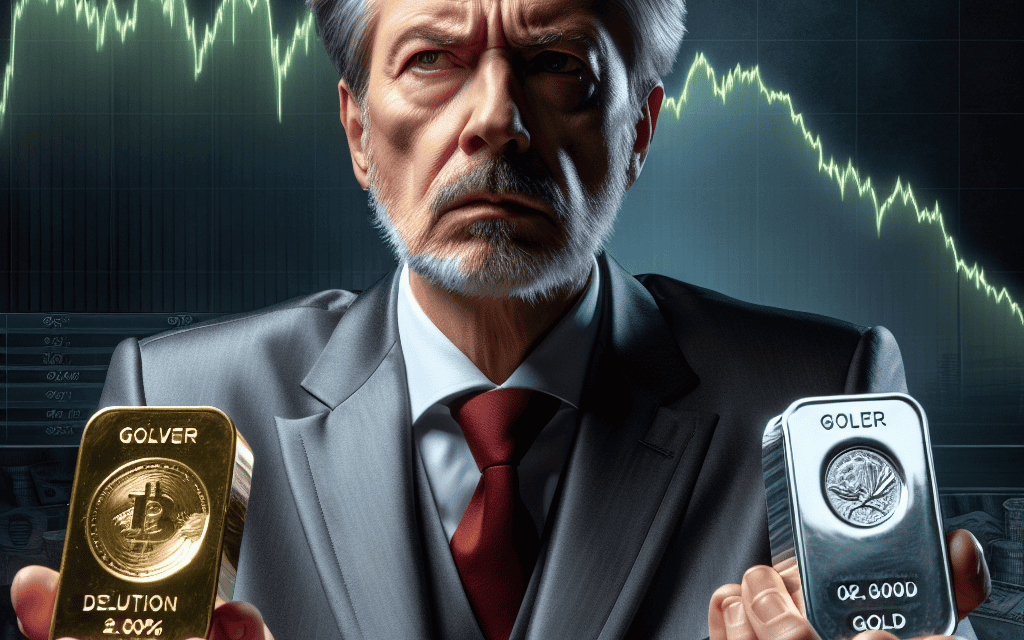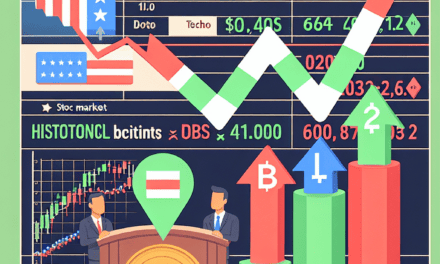“Jim Rogers Foresees Economic Storm: Silver Shines Brighter Than Gold in Looming Recession”
Introduction
Jim Rogers, a renowned investing expert and co-founder of the Quantum Fund, has recently issued a stark warning about an impending severe recession. Known for his astute market insights and successful investment strategies, Rogers has turned his attention to the precious metals market, expressing a preference for silver over gold. His prediction comes amidst growing economic uncertainties and market volatility, prompting investors to reconsider their portfolios. Rogers’ choice of silver is based on its industrial applications and potential for higher returns, positioning it as a more attractive investment compared to gold in the current economic climate. As global markets brace for potential downturns, Rogers’ insights offer a critical perspective for investors navigating these turbulent times.
Jim Rogers’ Recession Prediction: What It Means for Investors
Renowned investor Jim Rogers has recently made headlines with his prediction of an impending severe recession, a forecast that has captured the attention of investors worldwide. Known for his astute market insights and successful investment strategies, Rogers’ predictions are not to be taken lightly. As the global economy grapples with various challenges, his warning serves as a crucial reminder for investors to reassess their portfolios and strategies. Rogers’ perspective is rooted in a comprehensive analysis of current economic indicators, which suggest that the world is on the brink of a significant downturn. Factors such as rising inflation, geopolitical tensions, and the lingering effects of the COVID-19 pandemic have created a precarious economic environment. These elements, combined with high levels of debt in both developed and emerging markets, have led Rogers to conclude that a severe recession is not only possible but likely.
In light of this prediction, Rogers has also shared his preference for silver over gold as a safe-haven asset. Traditionally, gold has been the go-to asset for investors seeking stability during economic uncertainty. However, Rogers argues that silver presents a more compelling opportunity in the current climate. One reason for this preference is the industrial demand for silver, which is expected to rise as technological advancements continue to drive the need for this versatile metal. Silver’s dual role as both a precious metal and an industrial commodity positions it uniquely in the market, offering potential for both stability and growth.
Moreover, silver is currently undervalued compared to gold, presenting a more attractive entry point for investors. The gold-to-silver ratio, which measures the relative value of the two metals, suggests that silver is significantly cheaper than gold. This disparity provides an opportunity for investors to capitalize on silver’s potential appreciation as the market corrects itself. Additionally, silver’s historical performance during economic downturns has often mirrored that of gold, providing a similar level of security while offering the added benefit of potential industrial demand growth.
For investors, Rogers’ insights underscore the importance of diversification and strategic asset allocation. As the threat of a severe recession looms, it is crucial for investors to evaluate their portfolios and consider incorporating assets that can withstand economic turbulence. While traditional safe-haven assets like gold remain relevant, exploring alternatives such as silver could enhance portfolio resilience. Furthermore, Rogers’ prediction serves as a reminder of the cyclical nature of markets. Economic downturns, while challenging, also present opportunities for those who are prepared. By staying informed and adaptable, investors can navigate these turbulent times and potentially emerge stronger.
In conclusion, Jim Rogers’ prediction of a severe recession and his preference for silver over gold offer valuable insights for investors seeking to safeguard their portfolios. As the global economy faces mounting challenges, it is imperative for investors to remain vigilant and proactive. By considering Rogers’ analysis and adjusting their strategies accordingly, investors can better position themselves to weather the storm and capitalize on potential opportunities. As always, thorough research and careful consideration of individual financial goals and risk tolerance are essential in making informed investment decisions.
Silver vs. Gold: Why Jim Rogers Prefers Silver in Economic Downturns
In the realm of precious metals, the debate between silver and gold as investment choices has long intrigued both novice and seasoned investors. Renowned investing expert Jim Rogers has recently weighed in on this discussion, offering a perspective that is both insightful and timely. As the global economy teeters on the brink of a severe recession, Rogers has expressed a preference for silver over gold, a stance that merits closer examination.
To understand Rogers’ inclination towards silver, it is essential to consider the broader economic context. The world economy is currently facing a multitude of challenges, including geopolitical tensions, inflationary pressures, and the lingering effects of the COVID-19 pandemic. These factors have collectively contributed to an environment of uncertainty, prompting investors to seek safe havens for their capital. Traditionally, gold has been the go-to asset in times of economic distress, revered for its historical stability and intrinsic value. However, Rogers argues that silver presents a more compelling opportunity in the current climate.
One of the primary reasons for Rogers’ preference is the industrial demand for silver, which sets it apart from gold. Silver is not only a precious metal but also an industrial commodity with applications in various sectors, including electronics, solar energy, and medical devices. This dual role provides silver with a unique advantage, as its value is supported by both investment demand and industrial consumption. In contrast, gold’s value is predominantly driven by its status as a store of wealth, making it more susceptible to fluctuations in investor sentiment.
Moreover, Rogers highlights the relative affordability of silver compared to gold. Historically, the gold-to-silver ratio has been a key metric for investors, indicating how many ounces of silver are required to purchase one ounce of gold. This ratio has fluctuated significantly over time, and Rogers suggests that the current levels present an opportunity for silver to outperform gold. As silver is considerably cheaper, it offers a lower entry point for investors, potentially yielding higher returns if the market dynamics shift in its favor.
In addition to these factors, Rogers points to the potential for silver to benefit from the ongoing transition towards renewable energy. As governments and corporations worldwide commit to reducing carbon emissions, the demand for solar panels and electric vehicles is expected to surge. Silver, being a critical component in these technologies, stands to gain from this green revolution. This anticipated increase in demand could further bolster silver’s value, making it an attractive investment during economic downturns.
While Rogers acknowledges the enduring appeal of gold, he emphasizes that silver’s unique characteristics make it a more versatile asset in the face of a looming recession. The combination of industrial demand, affordability, and potential growth in the renewable energy sector positions silver as a promising alternative to gold. As investors navigate the complexities of the current economic landscape, Rogers’ insights serve as a valuable guide, encouraging a reevaluation of traditional investment strategies.
In conclusion, Jim Rogers’ preference for silver over gold in times of economic uncertainty underscores the importance of considering multiple factors when making investment decisions. By examining the interplay between industrial demand, market affordability, and emerging trends, investors can better position themselves to weather the challenges of a severe recession. As the debate between silver and gold continues, Rogers’ perspective offers a compelling case for diversifying one’s portfolio with an eye towards the future.
Preparing for a Severe Recession: Insights from Jim Rogers
In the ever-evolving landscape of global finance, the insights of seasoned investors often serve as a guiding light for those navigating uncertain economic waters. Jim Rogers, a renowned investing expert with decades of experience, has recently shared his perspective on the impending economic challenges that lie ahead. According to Rogers, the world is on the brink of a severe recession, a prediction that has captured the attention of investors and analysts alike. As economies worldwide grapple with inflationary pressures, geopolitical tensions, and the lingering effects of the COVID-19 pandemic, Rogers’ forecast underscores the need for strategic financial planning and prudent investment choices.
Rogers’ prediction of a severe recession is rooted in a confluence of factors that have been building over time. He points to the unprecedented levels of debt accumulated by governments and corporations as a significant concern. This debt, he argues, has created a fragile economic foundation that is vulnerable to shocks. Furthermore, the aggressive monetary policies adopted by central banks, including prolonged periods of low interest rates and quantitative easing, have, in his view, distorted asset prices and fueled speculative bubbles. As these bubbles begin to deflate, the resulting economic contraction could be severe.
In light of these challenges, Rogers advocates for a cautious approach to investing, emphasizing the importance of diversification and the need to hedge against potential downturns. While gold has traditionally been seen as a safe haven during times of economic uncertainty, Rogers has expressed a preference for silver as a more attractive investment option. He cites several reasons for this choice, including silver’s dual role as both a precious metal and an industrial commodity. This duality, he argues, provides silver with a unique advantage, as its demand is driven not only by investors seeking a store of value but also by industries reliant on its practical applications.
Moreover, Rogers highlights the historical price disparity between gold and silver, suggesting that silver is currently undervalued relative to gold. This presents an opportunity for investors to capitalize on potential price appreciation as market dynamics shift. Additionally, the increasing focus on renewable energy and technological advancements is expected to drive demand for silver, further bolstering its investment appeal. As the world transitions towards greener technologies, silver’s role in solar panels, electric vehicles, and other innovations positions it as a critical component of the future economy.
Transitioning from theory to practice, Rogers advises investors to remain vigilant and informed, continuously assessing the economic landscape and adjusting their portfolios accordingly. He underscores the importance of staying abreast of global developments, as geopolitical events and policy changes can have far-reaching implications for financial markets. By maintaining a flexible investment strategy and being prepared to adapt to changing conditions, investors can better navigate the challenges posed by a severe recession.
In conclusion, Jim Rogers’ insights serve as a timely reminder of the complexities inherent in today’s economic environment. His prediction of a severe recession, coupled with his preference for silver over gold, offers valuable guidance for those seeking to safeguard their financial future. As investors consider their options, the emphasis on diversification, vigilance, and adaptability remains paramount. By heeding these principles, individuals can position themselves to weather the storm and emerge resilient in the face of economic adversity.
The Future of Precious Metals: Jim Rogers’ Investment Strategy

In the ever-evolving landscape of global finance, the insights of seasoned investors often serve as a compass for those navigating the turbulent waters of economic uncertainty. Jim Rogers, a renowned investment expert with a track record of astute market predictions, has recently shared his perspective on the future of precious metals, particularly emphasizing his preference for silver over gold. As the world grapples with the looming threat of a severe recession, Rogers’ investment strategy offers a compelling narrative for those seeking refuge in tangible assets.
Rogers’ prediction of an impending severe recession is rooted in a confluence of economic indicators that suggest a downturn is on the horizon. With inflationary pressures mounting and central banks around the world grappling with the delicate balance of interest rates, the global economy appears to be teetering on the brink of contraction. In such a climate, investors traditionally turn to precious metals as a hedge against economic instability. However, Rogers’ preference for silver over gold marks a departure from conventional wisdom, inviting a closer examination of the factors influencing his choice.
One of the primary reasons Rogers favors silver is its dual role as both a precious metal and an industrial commodity. Unlike gold, which is primarily valued for its status as a store of wealth, silver’s applications extend into various industrial sectors, including electronics, solar energy, and medical devices. This dual demand provides silver with a unique resilience, as its value is not solely contingent on investor sentiment but also on industrial consumption. As technological advancements continue to drive demand for silver, its price is likely to benefit from both economic recovery and industrial innovation.
Moreover, Rogers points to the historical price ratio between gold and silver as a compelling argument for investing in silver. Traditionally, the gold-to-silver ratio has fluctuated, but in recent years, it has widened significantly, suggesting that silver is undervalued relative to gold. This discrepancy presents an opportunity for investors to capitalize on silver’s potential for appreciation, particularly if the ratio begins to revert to historical norms. By investing in silver, Rogers believes that investors can position themselves to benefit from both the metal’s intrinsic value and its potential for price correction.
In addition to these factors, Rogers highlights the geopolitical landscape as a critical consideration in his investment strategy. With global tensions and trade disputes on the rise, the demand for safe-haven assets is likely to increase. While gold has traditionally been the go-to asset in times of geopolitical uncertainty, silver’s affordability and accessibility make it an attractive alternative for a broader range of investors. This democratization of investment in precious metals could further bolster silver’s appeal, as more individuals seek to protect their wealth in an increasingly volatile world.
In conclusion, Jim Rogers’ investment strategy underscores the importance of adaptability and foresight in navigating the complexities of the global economy. By choosing silver over gold, Rogers not only challenges conventional investment paradigms but also highlights the multifaceted nature of silver as both a precious metal and an industrial commodity. As the specter of a severe recession looms large, Rogers’ insights offer a valuable perspective for investors seeking to safeguard their assets and capitalize on emerging opportunities in the precious metals market. Through careful analysis and strategic positioning, investors can potentially weather the economic storm and emerge with strengthened portfolios.
Understanding Jim Rogers’ Economic Forecast and Its Implications
Jim Rogers, a renowned investor and financial commentator, has recently made headlines with his prediction of a severe recession looming on the horizon. Known for his insightful analysis and successful investment strategies, Rogers’ forecasts are often taken seriously by both individual investors and financial institutions. His latest prediction, however, has sparked considerable debate and concern among economic analysts and market participants. Rogers’ assertion is grounded in his observation of several economic indicators that suggest an impending downturn. He points to the unprecedented levels of global debt, rising inflation, and geopolitical tensions as key factors that could trigger a significant economic contraction. Furthermore, Rogers highlights the potential for central banks to exacerbate the situation through policy missteps, such as raising interest rates too quickly or failing to address inflationary pressures effectively. These concerns are compounded by the lingering effects of the COVID-19 pandemic, which has disrupted supply chains and altered consumer behavior in ways that are still being understood.
In light of these predictions, Rogers has also shared his investment strategy, which notably includes a preference for silver over gold. Traditionally, gold has been viewed as a safe-haven asset during times of economic uncertainty. However, Rogers argues that silver presents a more compelling opportunity in the current environment. He cites several reasons for this preference, including silver’s dual role as both a precious metal and an industrial commodity. As industries such as electronics and renewable energy continue to grow, the demand for silver is expected to rise, potentially driving up its price. Additionally, Rogers points out that silver is currently undervalued compared to gold, suggesting that it has more room for appreciation.
Rogers’ emphasis on silver over gold is not merely a reflection of market trends but also a strategic decision based on historical patterns. He notes that during previous economic downturns, silver has often outperformed gold, offering investors higher returns. This historical perspective, combined with current market dynamics, forms the basis of his investment thesis. However, it is important to recognize that investing in precious metals, like any investment, carries risks. Market volatility, changes in industrial demand, and shifts in investor sentiment can all impact the price of silver. Therefore, while Rogers’ insights are valuable, investors should conduct their own research and consider their risk tolerance before making investment decisions.
The implications of Rogers’ economic forecast extend beyond individual investment choices. If his prediction of a severe recession proves accurate, it could have far-reaching consequences for global economies. Governments may need to implement fiscal stimulus measures to support growth, while central banks might be forced to reassess their monetary policies. Businesses could face challenges in maintaining profitability, leading to potential job losses and reduced consumer spending. On a broader scale, a recession could exacerbate existing social and economic inequalities, highlighting the need for comprehensive policy responses.
In conclusion, Jim Rogers’ prediction of a severe recession and his preference for silver over gold offer valuable insights into the current economic landscape. While his forecasts are grounded in thorough analysis, they also serve as a reminder of the inherent uncertainties in financial markets. As investors and policymakers navigate these challenges, Rogers’ perspectives provide a framework for understanding potential risks and opportunities in the months and years ahead.
How to Invest in Silver: Tips Inspired by Jim Rogers
In the ever-evolving landscape of global finance, investors constantly seek guidance from seasoned experts to navigate the complexities of market trends. One such expert, Jim Rogers, has recently made headlines with his prediction of a severe recession on the horizon. As investors brace for potential economic turbulence, Rogers has expressed a preference for silver over gold, sparking interest in how to strategically invest in this precious metal. Understanding the nuances of silver investment can provide a valuable hedge against economic downturns, and Rogers’ insights offer a compelling framework for those considering this path.
To begin with, it is essential to recognize the intrinsic value of silver as both an industrial and precious metal. Unlike gold, which is primarily used for investment and jewelry, silver has a wide array of industrial applications, ranging from electronics to solar panels. This dual demand can create unique opportunities for investors, as silver’s price is influenced by both economic growth and its status as a safe-haven asset. Consequently, when considering silver investment, it is crucial to stay informed about industrial trends and technological advancements that may impact demand.
Moreover, Jim Rogers emphasizes the importance of diversification within a silver investment strategy. While physical silver, such as coins and bars, is a popular choice for many investors, it is not the only option. Exchange-traded funds (ETFs) that track the price of silver offer a more liquid and accessible means of investment, allowing individuals to gain exposure to silver without the need for storage. Additionally, investing in silver mining stocks can provide leverage to the metal’s price movements, although this approach carries its own set of risks and requires careful analysis of each company’s financial health and operational efficiency.
Furthermore, timing plays a critical role in maximizing returns from silver investments. Rogers advises investors to adopt a long-term perspective, as silver prices can be volatile in the short term. By focusing on the broader economic cycle and identifying periods of undervaluation, investors can position themselves to benefit from eventual price recoveries. It is also prudent to monitor macroeconomic indicators, such as inflation rates and currency fluctuations, which can significantly influence silver’s appeal as a store of value.
In addition to these strategic considerations, investors should remain vigilant about the geopolitical landscape. Silver, like other commodities, is susceptible to geopolitical tensions and trade policies that can disrupt supply chains and affect prices. Staying informed about global events and their potential impact on silver markets is essential for making informed investment decisions.
Finally, it is important to acknowledge the psychological aspect of investing in silver. As with any investment, emotions can cloud judgment and lead to impulsive decisions. Jim Rogers advocates for a disciplined approach, encouraging investors to set clear objectives and adhere to their investment plans, even amidst market volatility. By maintaining a rational mindset and avoiding herd mentality, investors can better navigate the challenges of silver investment.
In conclusion, Jim Rogers’ preference for silver over gold in anticipation of a severe recession underscores the metal’s potential as a strategic investment. By understanding the unique characteristics of silver, diversifying investment approaches, timing market entry, and staying informed about global developments, investors can effectively incorporate silver into their portfolios. As the financial landscape continues to evolve, these insights provide a valuable foundation for those seeking to safeguard their wealth through silver investment.
Analyzing Jim Rogers’ Recession Warning: Key Takeaways for Investors
In the ever-evolving landscape of global finance, the insights of seasoned investors often serve as valuable guides for navigating uncertain economic waters. Jim Rogers, a renowned investor and financial commentator, has recently issued a stark warning about an impending severe recession. His perspective, shaped by decades of experience, offers crucial takeaways for investors seeking to safeguard their portfolios in turbulent times. As the world grapples with economic challenges, Rogers’ analysis provides a lens through which to understand potential market shifts and strategic investment choices.
Rogers’ prediction of a severe recession is rooted in a confluence of factors that have been brewing over recent years. He points to the unprecedented levels of debt accumulated by governments and corporations worldwide, a situation exacerbated by the economic fallout from the COVID-19 pandemic. This debt burden, according to Rogers, is unsustainable and could trigger a financial crisis reminiscent of past economic downturns. Furthermore, he highlights the potential for rising interest rates as central banks attempt to curb inflation, which could further strain economies already grappling with debt.
In light of these concerns, Rogers advocates for a cautious approach to investing, emphasizing the importance of diversification and risk management. He suggests that traditional safe havens, such as gold, may not be the optimal choice in the current economic climate. Instead, Rogers expresses a preference for silver, citing its dual role as both a precious metal and an industrial commodity. This duality, he argues, positions silver to benefit from both economic uncertainty and industrial demand, offering a potentially more resilient investment option.
Transitioning from the broader economic outlook to specific investment strategies, Rogers’ preference for silver over gold is noteworthy. While gold has long been considered a hedge against inflation and economic instability, Rogers believes that silver’s industrial applications provide an additional layer of security. As industries such as electronics and renewable energy continue to expand, the demand for silver is expected to rise, potentially driving up its value. This perspective challenges conventional wisdom and encourages investors to consider alternative assets that may offer greater growth potential in a recessionary environment.
Moreover, Rogers underscores the importance of geographical diversification in investment portfolios. He advises investors to look beyond traditional markets and explore opportunities in emerging economies, which may exhibit more robust growth prospects despite global economic headwinds. By diversifying across regions, investors can mitigate risks associated with localized economic downturns and capitalize on growth in areas less affected by the anticipated recession.
In conclusion, Jim Rogers’ warning of a severe recession serves as a clarion call for investors to reassess their strategies and prepare for potential market disruptions. His emphasis on diversification, both in terms of asset classes and geographical exposure, provides a roadmap for navigating uncertain times. By considering alternative investments like silver and exploring opportunities in emerging markets, investors can position themselves to weather the storm and potentially emerge stronger on the other side. As the global economy faces an array of challenges, Rogers’ insights offer a timely reminder of the importance of adaptability and foresight in the world of investing.
Q&A
1. **Who is Jim Rogers?**
Jim Rogers is a renowned investor and financial commentator, co-founder of the Quantum Fund, and author known for his insights on global markets.
2. **What is Jim Rogers’ prediction about the economy?**
Jim Rogers predicts a severe recession, suggesting that economic conditions will worsen significantly.
3. **Why does Jim Rogers predict a severe recession?**
Rogers cites factors such as high debt levels, economic imbalances, and potential policy missteps as reasons for his recession prediction.
4. **What is Jim Rogers’ stance on gold versus silver?**
Jim Rogers prefers investing in silver over gold, believing it has more potential for appreciation.
5. **Why does Jim Rogers favor silver over gold?**
Rogers argues that silver is undervalued compared to gold and has more industrial uses, which could drive demand and price increases.
6. **What are some of the industrial uses of silver?**
Silver is used in electronics, solar panels, medical devices, and various other industrial applications.
7. **How should investors approach the market according to Jim Rogers?**
Investors should be cautious, diversify their portfolios, and consider investing in assets like silver that may perform well during economic downturns.
Conclusion
Jim Rogers, a renowned investing expert, has predicted a severe recession, emphasizing the potential economic challenges ahead. In light of this forecast, Rogers has expressed a preference for investing in silver over gold. His choice is likely influenced by silver’s industrial applications, which could drive demand even during economic downturns, and its historical performance as a hedge against inflation. Additionally, silver’s lower price point compared to gold may offer more significant upside potential. Rogers’ insights suggest a strategic shift in investment focus, prioritizing assets that may offer resilience and growth opportunities amid anticipated economic turbulence.





